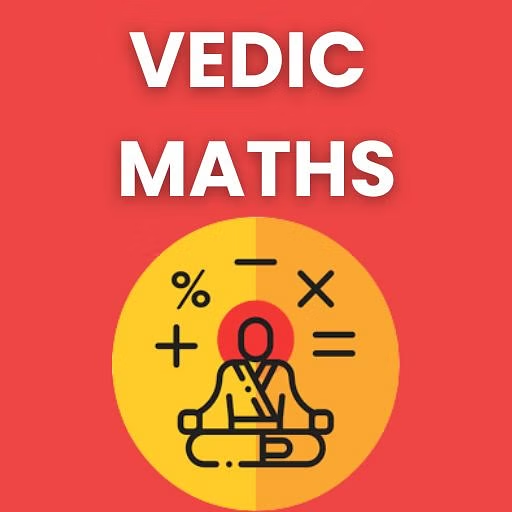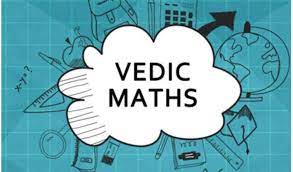
Vedic Mathematics:
Vedic Mathematics refers to a collection of ancient techniques and methods for performing arithmetic calculations, algebra, geometry, and other mathematical operations quickly and efficiently. These techniques are derived from the Vedas, which are ancient Indian scriptures, though the specific systems of mathematics within the Vedas are believed to have been developed much earlier.
Vedic mathematics is known for its ability to simplify complex calculations using mental math techniques, making it faster and more intuitive than conventional methods. These techniques are taught to improve mental agility and enhance the speed of calculations.
Historical Background:
- Origins: The system of Vedic mathematics was rediscovered by Sri Bharati Krishna Tirthaji in the early 20th century. He presented the idea in his book, Vedic Mathematics, published in 1965. However, it is believed that these techniques were developed centuries ago and were a part of the ancient Indian education system.
- Vedic Texts: The term “Vedic” comes from the Vedas, which are sacred texts in Hinduism. While the Vedas themselves do not contain mathematical content directly, the principles of Vedic Mathematics are based on certain sutras (short aphorisms) found in the ancient texts.
Core Concepts of Vedic Mathematics:
Vedic mathematics uses 16 Sutras (aphorisms) and 13 sub-sutras (corollaries) as the basis for its methods. These sutras describe ways to simplify calculations and solve problems more quickly. Some of the main concepts include:
- Sutra: “Ekadhikena Purvena” (One more than the previous one)
- This sutra is used in various types of problems, such as finding squares of numbers close to a base number (like 10, 100, etc.).
- Sutra: “Nikhilam Navatashcaramam Dashatah” (All from 9 and the last from 10)
- This technique is used for multiplication of numbers that are close to powers of 10. It involves subtracting the digits from 9 and 10 to simplify the calculation.
- Sutra: “Urdhva-Tiryak” (Vertically and crosswise)
- This is a general multiplication formula that can be used for multiplying numbers of any size. It is similar to the cross-multiplication method but more systematic and faster.
- Sutra: “Sankalana-Vyavakalanabhyam” (By addition and subtraction)
- This is used for solving algebraic equations quickly. It applies to problems that require addition and subtraction of terms.
- Sutra: “Paraavartya Yojayet” (Transpose and adjust)
- This sutra is used to solve problems involving fractions or algebraic equations by adjusting the terms systematically.
- Sutra: “Shunyam Saamyasamuccaye” (When the sum is the same, that sum is zero)
- This sutra is used for simplifying expressions that result in zero, particularly in algebraic simplifications.
- Sutra: “Anurupyena” (Proportionality)
- This sutra is used for solving problems involving ratios and proportions. It helps in simplifying proportional relationships in geometry or arithmetic.
- Sutra: “Chalana-Kalana” (Differentiation and Integration)
- This sutra is used for solving calculus problems using simple mental strategies, enabling quick differentiation and integration.
Key Techniques and Applications of Vedic Mathematics:
- Multiplication:
- Multiplying large numbers: Vedic techniques like Urdhva-Tiryak (crosswise multiplication) allow users to multiply numbers much faster by breaking them down into simpler steps. For example, multiplying two-digit numbers is much faster and more systematic.
- Squaring Numbers:
- Using the sutra “Ekadhikena Purvena”, squaring numbers near a base number like 100 becomes extremely quick. For example, squaring 98 (which is 2 less than 100) can be done by subtracting 2 from 100 and then using a quick formula.
- Division:
- Vedic division methods are based on successive approximations and using parts of the divisor to simplify the process. The methods allow for faster mental division.
- Finding Square Roots and Cube Roots:
- The Vedic method of finding square roots uses a direct method that can be done without long division. Similarly, cube roots can be found by using specific formulas and tricks.
- Solving Algebraic Equations:
- The sutras are particularly effective in solving algebraic problems. For example, they allow for a quicker solution to quadratic equations and higher degree equations, using the methods of addition and subtraction or proportionality.
- Fractions:
- Vedic methods can simplify fraction operations, such as addition, subtraction, and multiplication of fractions, with faster mental techniques.
- Geometric Calculations:
- Vedic math techniques extend to geometry as well, where problems involving areas, volumes, and other geometric properties are solved efficiently.
Examples of Vedic Mathematics in Action:
- Multiplying 23 × 41:
- Using the Urdhva-Tiryak method (vertically and crosswise), you break it down into smaller steps.
- Squaring 97 (using Ekadhikena Purvena):
- Since 97 is 3 less than 100, subtract 3 from 100 to get 97, then square 3 to get 9.
- Subtract 3 × 97 = 291 from 10000:
Benefits of Vedic Mathematics:
- Speed: The techniques are designed to speed up calculations, allowing for faster mental math.
- Simplicity: The methods make complex calculations easier and more intuitive, eliminating the need for long procedures or memorizing complicated formulas.
- Mental Agility: Regular practice of Vedic techniques helps improve memory, concentration, and mental calculation skills.
- Improved Confidence: Vedic Mathematics can boost confidence in students and professionals by making math seem less intimidating and more fun.
Criticism and Limitations:

- Lack of Formalization: Some critics argue that Vedic Mathematics isn’t a coherent system but rather a collection of tricks and methods without formal proofs or a clear mathematical framework.
- Limited Scope: While Vedic mathematics is highly effective for specific types of arithmetic and algebraic operations, it does not cover every aspect of modern mathematics, particularly calculus or higher-level algebra.
Conclusion:
Vedic Mathematics provides an ancient yet highly effective set of tools for performing arithmetic and algebraic calculations quickly and accurately. While the methods are particularly beneficial for mental calculations and learning, they also offer an alternative approach to traditional methods, making math more engaging, accessible, and efficient.

Leave a Reply